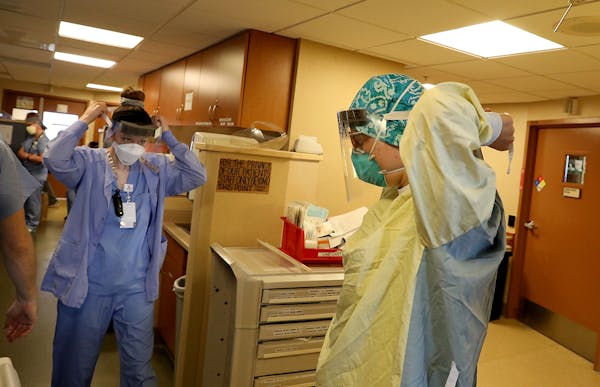Gov. Tim Walz urged Minnesotans to stick with mask-wearing and social distancing to reduce the spread of COVID-19 after conferring with a top White House official over the weekend and looking at troubling infection growth rates in bordering states.
"The next six to 12 weeks are going to be critical in this fight on COVID," Walz said Monday at a news conference.
Walz and state health officials struck perhaps their most concerning tone in weeks regarding the pandemic — with several meaningful metrics of the spread of the novel coronavirus going in the wrong direction.
The state's COVID-19 dashboard shows a hospitalization rate that is near the first surge of the pandemic in May and a positivity rate of diagnostic testing that has risen above the warning threshold of 5% to nearly 7% over the past two weeks.
The Minnesota Department of Health on Monday reported four COVID-19 deaths, but the seven-day total of 114 is one of the highest death tolls since mid-June. The state has now reported 2,353 COVID-19 deaths since late March, and a total of 135,732 known infections — including 1,578 reported on Monday.
Infections increased 22% in Minnesota from mid-August to mid-September but 83% from mid-September to mid-October, said Jan Malcolm, state health commissioner. While increased testing is likely finding more mild or asymptomatic cases that weren't identified in the past, the data suggest wider spread of the virus as well.
"Because the case positivity rate is going up, not down ... we know this is not just an artifact of testing more, but that there is more disease out there around our state," she said.
New infections were reported Monday in 83 of Minnesota's 87 counties. The latest White House report on Minnesota listed 12 mostly rural counties as being in the "red zone" because their new infection rates had risen above 100 per 100,000 people a week.
The report ranked Minnesota with the 19th highest rate of COVID-19 infection growth. The Dakotas had the nation's highest rates; Wisconsin had the fourth-worst rate.
Dr. Deborah Birx, an adviser on the White House COVID-19 task force, told Walz this weekend that Minnesota has the resources to avoid similar surges, but the governor said the state could end up like Wisconsin without renewed public compliance with safety measures.
"We're talking about high spikes here of 2,200 cases; they were reporting 6,000 cases, hospitals overflowing and temporary beds being set up at the fairgrounds," Walz said. "That is the crystal ball of our future. ... All of those things will end up happening [here] if we don't make some of these changes."
Walz said he wants to avoid stringent shutdowns of businesses or schools when considering that 95% compliance with mask-wearing would be more effective.
State health officials are concerned by signs of "COVID fatigue" and survey data indicating that mask-wearing is less common in Minnesota than in some other states, especially in some rural counties.
Carnegie Mellon University's COVIDcast showed 95% of people surveyed in Hennepin County wore masks in public all or most of the time, while the rate in rural Minnesota was 83%. Rates vary from 71% in South Dakota to 95% in Massachusetts.
The Institute for Health Metrics and Evaluation in Washington state predicts more than 4,800 COVID-19 deaths in Minnesota by year's end, but less than 4,100 if the state had 95% compliance with mask-wearing in public.
Compliance varies by setting — with many people wearing masks in stores but not wearing them in social gatherings that cause many outbreaks, said Kris Ehresmann, state infectious disease director. She stressed that mask-wearing alone provides limited protection if people don't avoid large crowds.
"Fewer people means less risk, but it doesn't mean no risk. Outside means less risk, but it doesn't mean no risk. Masks mean less risk but not no risk. That is why we say the more layers of protection you build in, the better off we are," she said.
Sporting events remain a concern, she added, and are associated with 3,410 known infections, or 2.5% of the total. That includes 593 people involved with high school-age athletics.
"Just in the last week we have added two confirmed outbreaks in high schools — one in volleyball, one in soccer," she said.
Doctors at HCMC in Minneapolis and other safety-net hospitals around the country joined in calls for increased public compliance. Dr. James Miner, HCMC's chief of emergency medicine, said he can see the gradual erosion of compliance that occurs at sporting events and other activities.
"Each game you're a little bit closer, you have a little bit longer conversations, the masks start to come off," Miner said.
Walz said Minnesota has one advantage in widespread testing availability that it lacked when COVID-19 first surged in May. That includes the addition of five free state saliva-testing sites and a lab processing facility in Oakdale to provide results within 48 hours.
"Testing is the key to stopping the chain of the virus spread," Walz said.
U.S. Health and Human Services on Monday also announced the continuing shipment of 1.7 million rapid antigen tests to Minnesota from its initial stockpile of 150 million.
While slightly less accurate, antigen testing can be quicker than standard diagnostic PCR testing, which can be useful to identify outbreaks early on in nursing homes and other high-risk settings. More than 80% of COVID-19 deaths in Minnesota have involved people 70 or older, and 76% have involved residents of long-term care or assisted-living facilities.
Jeremy Olson • 612-673-7744
Body camera video shows Minnetonka man shooting at deputies several times before dying in firefight
Charge: Driver going 77 mph ran red light, fatally hit man crossing St. Paul street and kept going
Minnesota Senate GOP files ethics complaint against Sen. Nicole Mitchell
High school archer focuses on target: another national championship

